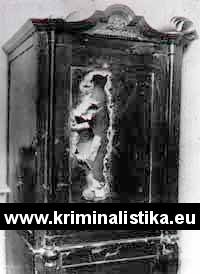Martin Lecián
Born on October 31st, 1900, Předměstí near Uherský Ostroh - Executed on October 6th, 1927, Olomouc

The dangerous deserter, thief, safebreaker and murderer became a kind of legend at that time. Lecián was still alive when the organ-grinders were wandering about the town and small streets singing their "sad and touching songs" on Lecián and his life. Lecián believed he had become a legend and that was his road to hell. He was executed by Leopold Wohlschlager, the headsman, in the Olomouc court yard, early in the morning of October 6th, 1927.
The legend says Lecián is a handsome and still nice-smiling thief-gentleman, a excellent safebreaker never been caught redhanded by the limb of the law... But the reality is completely different. Having some troubles even when being brought up, he is soon put to house of correction where he stays till he is eighteen. After having been released from the house of correction, Lecián starts stealing. He is punished by the court in Uherské Hradiště twice. During his military service, Lecián deserted five times, on December 10th, 1926, for the very last time. He is arrested after 134 days. Lecián is accused of committing 104 crimes, including ten acts of murder, both perpetrated and attempted. Police constable, Antonín Stuchlý, becomes the victim of Lecián's. He is shot dead during an ordinary control procedure.
The murdered police constable Antonín Stuchlý

The sentence is passed on September 3rd, 1927, saying Lecián was murdering just not be caught and arrested. He was terribly affraid of being arrested. Who dares to approach him without saying: "Roses are red" is shot dead in no time. Martin Lecián, paying no attention to his solicitor, accepts the death penalty and still at the court, he asks the President for the general pardon. What is more, he does not appeal from the judgement...
Due to the witnesses, authorized experts and Lecián himself, the Lecián of the legend changes into the Lecián of the reality. He cannot answer some of the judge's questions and if he can, he answers: "I don't remember." The general public were looking forward to the trial, but they became disappointed. Lecián himself becomes disappointed too. Nobody admires him now. The newspapers say: "Lecián is not the man we thought him to be!"... The police investigations prove that Lecián is not so brilliant safebreaker as the general public think. He breaks only the old-fashioned safes made in the middle of the 19th century. Suffering from tuberculosis, Lecián cannot breath properly. What is more, the surface sheets are filled with ash, which make Lecián cough and thus he places a wet scarf over his mouth and that is why that piece of cloth is found at the scene of crime lying next to the botched-up open safe...
The broken safe

But something strange happens at night, from September 25th to September 26th. Despite all the precautions, Lecián manages to escape from the cage and gets possession of a gun. He shoots dead a twenty-year-old warden. All hell breaks loose in the corridor and more than one hundred shots are fired. After that, having found out there is no way to escape from the corridor, Lecián gives up.
Despite of the facts mentioned above, newspapers write articles on Lecián, singing the praises of "his brave deeds". The rapid course of events follows: seven days later, on October 3rd, 1927, T. G. Masaryk refuses Lecián's plea for mercy. Three day later, Martin Lecián is executed. And it also is the very last execution led by the famous headsman, Leopold Wohlschlager.
© Miloslav Jedlička, D. C. L.
Translated by inspector WO Pavel Vršovský, M. A.